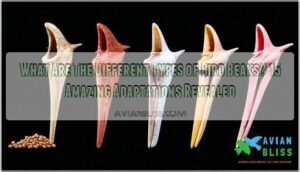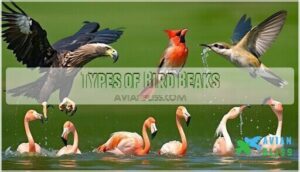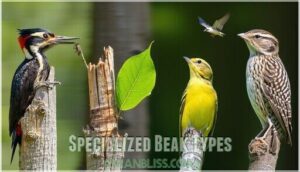This site is supported by our readers. We may earn a commission, at no cost to you, if you purchase through links.

Common types include conical beaks (finches) for cracking seeds, hooked beaks (eagles) for tearing meat, probing beaks (woodpeckers) for drilling, filter beaks (flamingos) for sifting food, and spear-like beaks (herons) for catching fish.
Hummingbirds have needle-like beaks for extracting nectar, while crossbills have uniquely crossed tips for prying open pine cones.
These different types of bird beaks are functional tools shaped by natural selection—each design solving specific feeding challenges. The remarkable precision of these adaptations reveals nature’s engineering at its finest, showcasing evolved beaks.
Table Of Contents
- Key Takeaways
- Bird Beak Basics
- Types of Bird Beaks
- Beak Shapes and Functions
- Specialized Beak Types
- Beak Adaptations and Examples
- Frequently Asked Questions (FAQs)
- What are the 4 types of bird beaks?
- What were the differences in the bird’s beaks?
- How to identify birds by beak?
- What are the 4 types of beaks?
- Why are some birds beaks different?
- What are the types of bird beaks?
- What were the differences in the birds beaks?
- Why are bird beaks different shapes?
- How do birds sense taste with their beaks?
- Can beaks regenerate after severe damage or loss?
- Conclusion
Key Takeaways
- You’ll see that bird beaks are specialized tools shaped by natural selection, made of keratin covering bone that continuously grows throughout a bird’s life.
- Bird beak types include hooked beaks for tearing meat (eagles), conical beaks for cracking seeds (finches), tubular beaks for sipping nectar (hummingbirds), and drill-tipped beaks for wood excavation (woodpeckers).
- You can identify birds by their beak shape—predators have hooked beaks, seed-eaters have conical ones, insectivores have thin straight bills, and nectar-feeders often have curved beaks.
- Bird beaks serve multiple functions beyond feeding, including nest building, preening, defense, thermoregulation, and communication, with each beak’s unique morphology revealing the bird’s ecological niche.
Bird Beak Basics
Bird beaks are incredible tools, shaped by evolution to help birds survive and thrive in their environments.
Their structure, made of bone and keratin, determines how they eat, build nests, and interact with the world around them, which is an incredible tool for their survival.
Beak Structure and Function
Beaks are remarkable structures that define a bird’s survival toolkit.
You’ll find they’re composed of bone covered in keratin, much like your fingernails.
Bird beaks continuously grow and wear down throughout life.
Their anatomy includes specialized musculature that controls precise movements, while sensory perception cells help birds detect food.
Each beak’s morphology serves multiple functions: obtaining food, feeding young, preening, defense, building nests, regulating temperature, and communication.
Their beak’s unique structure is essential for a bird’s daily activities, including obtaining food.
Beak Evolution and Adaptation
Bird beaks have constantly evolved through adaptive radiation, responding directly to environmental pressures and dietary specialization needs.
Bird beaks constantly evolve through adaptive radiation, showcasing nature’s brilliant response to environmental pressures and dietary needs.
You’ll notice this remarkable process in Darwin’s finches, whose varied beak morphology developed from a single ancestor.
The fossil record reveals how avian adaptation occurs through genetic mutations that prove advantageous for feeding.
When food sources change, birds with helpful beak variations survive and pass these traits to offspring, illustrating the concept of natural selection.
Beak Types and Characteristics
After evolving over millennia, bird beaks now display remarkable diversity in their types and characteristics. You’ll find these specialized structures vary widely based on feeding habits and environmental adaptations.
Bird beak types feature four key components:
- Beak material (primarily keratin covering bone)
- Beak strength (varies by function)
- Beak coloration (often signals health or mating status)
- Beak sensory capabilities (containing nerve endings for detection)
Bird beak shapes directly reflect their specialized functions in nature. Beaks also facilitate displays of courtship among birds, which is a crucial aspect of their environmental adaptations and overall diversity in beak types, showcasing their unique characteristics.
Types of Bird Beaks
When you look at a bird, you’ll notice its beak is perfectly designed for its lifestyle. Birds have developed an incredible variety of beak types to help them survive in their environments.
| Beak Type | Function | Example | Material | Strength |
|---|---|---|---|---|
| Hooked | Tearing flesh | Eagle | Keratin | Very high |
| Conical | Cracking seeds | Cardinal | Keratin | High |
| Tubular | Sipping nectar | Hummingbird | Keratin | Low |
| Chisel | Drilling wood | Woodpecker | Keratin | High |
| Filter | Straining water | Flamingo | Keratin | Medium |
Beak material consists primarily of bone covered with keratin that continuously regrows as it wears down. Beak size varies dramatically across species, from tiny hummingbird bills to massive toucan beaks.
Beak coloration often plays a role in mating displays, while beak angle and bird beak shapes directly correspond to feeding habits. Many white birds use wetlands as their habitat.
The diversity of bird bills demonstrates nature’s remarkable adaptive abilities.
Beak Shapes and Functions
You’ll notice that a bird’s beak shape directly determines what it can eat and how it interacts with its environment.
Bird beaks are nature’s Swiss Army knives—each shape perfectly designed for a specific survival challenge.
Each beak type, from the hawk’s sharp hook for tearing meat to the hummingbird’s slender tube for sipping nectar, represents a specialized tool perfectly adapted to access specific food sources, showcasing how each species’ beak is a unique adaptation to its ecological niche.
Hooked Beaks for Meat Eating
You’ll easily recognize carnivorous birds by their hooked beaks, perfectly designed for hunting efficiency.
These specialized beaks allow raptors like eagles and hawks to tear flesh with remarkable precision.
When hunting, they use their sharp, curved beaks to kill prey by biting the neck. This beak morphology gives birds of prey an evolutionary advantage, making them efficient hunters capable of consuming mammals, birds, and reptiles.
These beaks, made of keratin, are continuously growing structures.
Cone-Shaped Beaks for Seed Eating
While hooked beaks tear flesh, cone-shaped beaks serve as nature’s nutcrackers. These conical beaks work like specialized tools, perfectly designed for cracking open seeds and nuts.
You’ll notice these powerful seed-eating beaks on finches and cardinals.
- You can’t help but marvel at how these little birds crack tough shells with such precision
- Nature’s design is truly incredible – the perfect beak morphology for each dietary need
- It’s fascinating to imagine the evolutionary journey that created these specialized tools
Seed dispersal happens naturally as birds with conical beaks travel, dropping seeds along their journey.
Tubular Beaks for Nectar Feeding
For nectar feeding, tubular beaks serve as specialized straws that allow birds to extract sweet energy from flowers.
These long, slender beaks reach deep into blossoms where nectar hides.
| Bird Example | Tubular Beak Feature | Feeding Advantage |
|---|---|---|
| Hummingbirds | Extremely thin, elongated | Reaches deepest flowers |
| Sunbirds | Curved, delicate | Accesses curved blossoms |
| Honeyeaters | Medium length, slightly curved | Versatile flower feeding |
| Hawaiian honeycreepers | Varied shapes evolved from one ancestor | Island-specific adaptations |
| Spiderhunters | Extra long, strongly curved | Specialized for specific tropical flowers |
Straight Beaks for Insect Catching
While hummingbirds sip nectar through their specialized tubes, many birds have evolved straight beaks perfectly designed for catching insects.
These thin, pointed structures work like precision tweezers, allowing insectivores to pick bugs off leaves with remarkable accuracy.
Swallows use their straight beaks to snatch insects mid-flight, while other species probe bark and soil.
This beak morphology offers evolutionary advantages by helping birds access protein-rich food sources that sustain their high-energy lifestyles.
Specialized Beak Types
You’ll find that some birds have developed highly specialized beaks that perform very specific functions beyond just eating.
These unique beak adaptations include drill-tipped beaks for wood excavation, tweezer-tipped beaks for insect gleaning, wide flattened beaks for catching insects mid-air, and scythe-shaped beaks for specialized foraging techniques.
Drill-Tipped Beaks for Wood Excavation
The chisel-like beaks of woodpeckers represent nature’s perfect drilling tool.
You’ll notice these specialized beaks have evolved specifically for wood excavation, allowing woodpeckers to create nests and extract insects from tree bark.
Their remarkable beak durability withstands repeated impacts during foraging behavior.
Woodpecker anatomy includes reinforced skull structures that prevent brain damage while drilling.
These bird beaks function as both home-building tools and efficient feeding implements.
Some retailers offer specialized tools for birders.
Tweezer-Tipped Beaks for Insect Gleaning
While woodpeckers excel at drilling, other birds have developed precision instruments for different feeding challenges.
Tweezer-tipped beaks are slender, precise tools that allow birds like warblers, wrens, and nuthatches to perform insect gleaning with remarkable efficiency.
These specialized bird bills work perfectly for foliage foraging, letting these insectivores carefully pick tiny bugs from leaves, bark crevices, and branches.
You can even purchase specialized feeding tools to simulate this adaptation. Beak morphology in these species supports their specific feeding adaptations.
Wide Flattened Beaks for Insect Catching
While tweezer-tipped beaks excel at precision, wide flattened beaks serve as nature’s nets.
These specialized beaks increase surface area for catching insects mid-air. Aerial insectivores like flycatchers, tree swallows, and purple martins showcase this beak morphology.
Their wide beak design creates efficient catching mechanisms, allowing birds to snatch flying insects with remarkable accuracy.
This evolutionary advantage helps these birds thrive in specific habitat niches where airborne prey is abundant.
Scythe Beaks for Foraging
While scythe beaks sweep back and forth through water and mud, their distinctive curved shape makes them perfect for specialized foraging. American avocets demonstrate this remarkable adaptation when feeding in shallow waters.
Five key features of scythe beak morphology include:
- Upward curve design
- Thin, elongated structure
- Flexible movement capabilities
- Precise tactile sensitivity
- Specialized mudflat feeding efficiency
This wading adaptation represents a fascinating example of beak evolution, allowing birds to access food sources others can’t reach.
Beak Adaptations and Examples
You’ll find that bird beaks are highly specialized tools that have evolved to match specific feeding habits and environmental conditions.
Each beak type, from the hooked bills of eagles to the filter-feeding structures of flamingos, represents an adaptation that helps birds survive in their particular ecological niche.
Beaks for Specific Food Sources
Through millions of years of evolutionary pressures, bird beaks have developed remarkable specializations for specific food sources.
You’ll notice that hooked beaks in eagles and hawks are perfectly designed for tearing flesh, while cone-shaped beaks in finches and cardinals efficiently crack seeds.
Tubular beaks in hummingbirds extract nectar with precision. This beak morphology directly reflects dietary specialization, with each adaptation allowing birds to exploit unique feeding ecologies and reduce resource partitioning competition.
Evolutionary pressures have led to these distinct beak shapes, showcasing the incredible adaptability of birds to their environments.
Beak Adaptations for Aquatic Environments
While some birds hunt on land, others have developed specialized beaks for aquatic environments.
Waterfowl beaks are perfectly adapted to their watery habitats and food sources. Understanding waterfowl beak morphology is essential to appreciate their feeding strategies.
Here are four remarkable aquatic beak adaptations:
- Filter-feeding beaks that strain tiny organisms from water (ducks, flamingos)
- Serrated bills that grip slippery fish (mergansers)
- Scoop bills with pouches for catching fish (pelicans)
- Probing beaks for finding invertebrates in mud or sand (shorebirds)
Beak Examples in Different Bird Species
Looking across the avian world, you’ll find remarkable beak diversity perfectly matched to feeding habits.
Various bird species showcase specialized bills that have evolved over time.
| Bird Type | Beak Description | Primary Function |
|---|---|---|
| Raptor Beaks | Sharp, hooked | Tearing prey |
| Shorebird Bills | Long, slender | Probing mud |
| Finch Variations | Short, conical | Cracking seeds |
Waterfowl beaks feature filtering edges, while parrot mandibles are strong for crushing nuts.
Hummingbirds possess needle-like bills for reaching deep into flowers.
Unique Beak Features and Functions
Beaks do far more than just help birds eat.
You’ll notice beaks serve as multipurpose tools for thermoregulation, communication, defense, preening, and nest-building.
Each beak’s shape indicates a bird’s diet and ecological niche. This morphology results from evolution tailoring bills to specific feeding adaptations.
When you observe birds closely, their beaks reveal their lifestyle, from seed-cracking specialists to flesh-tearing predators. Birds also have unique skeletal adaptations to assist with these diverse functions, which are a result of evolution and their specific ecological niche.
Frequently Asked Questions (FAQs)
What are the 4 types of bird beaks?
While some birds tear flesh with hooked beaks, others crack seeds with conical ones.
You’ll find straight beaks catching insects, and probing beaks extracting food from soft ground.
Each serves a unique purpose.
What were the differences in the bird’s beaks?
Bird beaks differ in shape, size, and function.
You’ll notice hooked beaks for tearing flesh, conical ones for crushing seeds.
Long thin bills are used for nectar, and chisel-tipped beaks are for drilling into wood.
How to identify birds by beak?
To identify birds by beak, observe its shape and size.
Hooked beaks indicate predators, conical ones suggest seed-eaters, thin straight bills point to insectivores, while curved ones often belong to nectar-feeders.
What are the 4 types of beaks?
The four main types of bird beaks are conical (for seed-cracking), hooked (for tearing flesh), straight/pointed (for catching insects/fish), and filter-feeding (for straining food from water).
Each shape determines what they’ll eat.
Why are some birds beaks different?
You’ll notice different beaks have evolved to match specific diets and lifestyles.
They’re specialized tools – hooked for tearing meat, conical for cracking seeds, or long and thin for sipping nectar.
What are the types of bird beaks?
You’ll find several types of bird beaks including hooked (for tearing meat), conical (for crushing seeds), drilling (for wood excavation), tubular (for nectar).
Filter-feeding (for straining water), and probing (for soft ground feeding).
What were the differences in the birds beaks?
Bird beaks differ based on function and diet.
You’ll see hooked beaks for tearing flesh, conical beaks for crushing seeds, long thin beaks for probing, and flat wide beaks for filtering water.
Why are bird beaks different shapes?
Bird beaks evolved to match their diets and lifestyles.
You’ll find hooked beaks for tearing meat, conical ones for cracking seeds, and long, thin ones for sipping nectar.
Form perfectly follows function.
How do birds sense taste with their beaks?
Unlike humans, you’ll find birds have fewer taste buds (typically under 100) located at the back of their beaks and throats, allowing them to taste food as they’re swallowing it.
Can beaks regenerate after severe damage or loss?
Like a phoenix rising from ashes, your bird’s beak can partially regenerate after damage.
The keratin covering regrows continuously, but severe structural damage to the underlying bone won’t fully heal without intervention, which highlights the importance of intervention in the healing process of severe damage.
Conclusion
Bountiful bird beaks beautifully demonstrate nature’s incredible engineering.
Whether you’ve witnessed woodpeckers drilling, hummingbirds sipping, or eagles tearing, you’re seeing specialized tools shaped by evolution.
The different types of bird beaks serve as perfect adaptations to their environments and diets.
From filter-feeding flamingos to seed-cracking finches, each design solves specific feeding challenges, representing millions of years of evolutionary refinement.
Next time you watch birds, you’ll appreciate how these remarkable structures represent a testament to nature’s ingenuity, showcasing incredible engineering.







